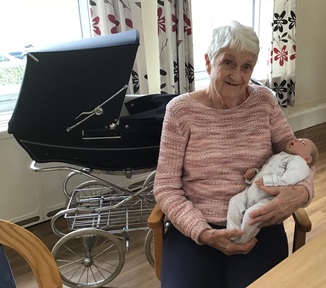Dementia doll therapy brings 'joy' to care home residents 'like nothing I've seen before'
A care home in Kent has been using doll therapy with its residents, with its deputy manager revealing it has brought “joy like nothing I have seen before”.

Edward Moore House in Gravesend was given a lifelike doll by reborn artist Tricia Bethel and the effect on the residents has been “heartwarming and emotional”.
Deputy manager Melanie Martin, said: “Looking after the baby doll has had a significant calming effect, when residents are feeling unsettled or restless. It gives them a sense of worth and purpose and their reactions have brought the staff to tears, as they watch them interact and take it in turns to hold the baby.”
Doll therapy can be controversial as some believe it infantilizes people with dementia. However care home staff do find that giving people with dementia a doll to cuddle and talk to can be hugely comforting and can be very useful in calming them if they are distressed and agitated.
After the baby doll’s arrival, former employee and friend of the home, Maggie Town, sourced a classic Silver Cross pram, which one resident Marylyn loves to use to push the doll around the home. A staff member revealed that another resident Jean stopped to hold the doll and told Marlyln how she couldn’t have children and she’s so lucky to be able to hold Marylyn’s baby.
Ms Martin said: “The effect the baby has on the residents is heartwarming and emotional, it brings them joy like nothing I have seen before. When the baby is around the whole mood changes, they speak quietly as not to wake her and they are so gentle with her, it’s beautiful to see.

“Trish, who is a reborn artist hand paints all of her dolls and she does an excellent job as they are very realistic. We are so grateful for what she has done for our home.”
Gary Mitchell, who wrote the book Doll Therapy in Dementia Care, believes that if dementia doll therapy is used correctly, it can make a real positive difference to a person with dementia.
He attributes this to a “need for attachment in a time of greater uncertainty” and says: “For people living with dementia a doll can arguably act as an anchor in an ever-changing sea of uncertainty”.
Care home staff do need to monitor residents’ interactions with the dolls very carefully. Some care homes have found residents can get too attached to the dolls, putting them to sleep in their beds, for example, while they sleep in the chair. They have also led to arguments between residents.
However there are huge benefits with studies showing that doll therapy does lead to increased levels of engagement with other people, reduction in episodes of distress, improved dietary intake and generally an increased level of wellbeing with the therapy now used in the UK, Australia, Japan and the USA.
Latest News
 29-Jul-24
Dementia Bus gives carehome.co.uk staff insight into life with dementia
29-Jul-24
Dementia Bus gives carehome.co.uk staff insight into life with dementia
 01-Mar-24
Find out the top care homes in 2024
01-Mar-24
Find out the top care homes in 2024
 21-Mar-23
UK's top care homes in 2023 revealed
21-Mar-23
UK's top care homes in 2023 revealed
 03-Jan-23
carehome.co.uk launches free care helpline
03-Jan-23
carehome.co.uk launches free care helpline
 13-Dec-22
5 mins with Emily Whitehurst, chief operating officer for Constantia Healthcare
13-Dec-22
5 mins with Emily Whitehurst, chief operating officer for Constantia Healthcare